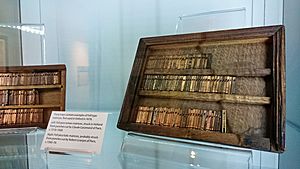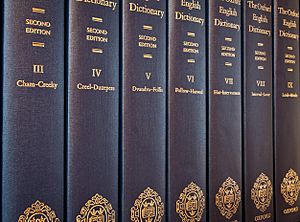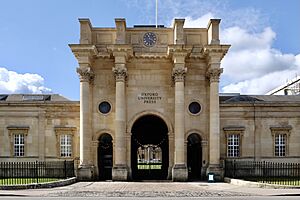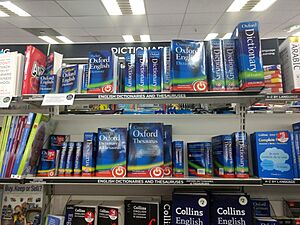Oxford University Press facts for kids
 |
|
| Parent company | University of Oxford |
|---|---|
| Founded | 1586 |
| Country of origin | United Kingdom |
| Headquarters location | Oxford, England |
| Key people | Nigel Portwood (Secretary to the Delegates and CEO) |
| Publication types |
|
| Imprints |
|
| No. of employees | 6,000 |
Oxford University Press (often called OUP) is the publishing company of the famous University of Oxford. It is the biggest university publisher in the whole world. OUP printed its first book in Oxford way back in 1478. The company officially got the right to print books in 1586. It is the second oldest university publisher, after Cambridge University Press.
OUP is a part of the University of Oxford. A group of 15 university experts, called the Delegates of the Press, manage it. These Delegates are chosen by the university's leader, the vice-chancellor. The head of the Delegates is also OUP's chief executive. This way of running things has been around since the 1600s. The main office is in Oxford, England, on Walton Street.
For over 400 years, OUP has mostly published books for learning. Today, it still publishes many things. These include school books, journals for experts, dictionaries, and books to help people learn English. They also publish books on history, music, and classic stories. You can find Bibles and atlases from OUP too.
OUP has offices all over the world. Many of these are in places that were once part of the British Empire.
Contents
The Story of Oxford University Press

The University of Oxford started printing around 1480. It became well-known for printing Bibles, prayer books, and scholarly works. In the 1630s, Archbishop William Laud helped the university get special rights. These rights allowed Oxford to print all kinds of books. This included the important King James Version of the Bible. Printing Bibles brought a lot of money to OUP for many years.
After a big conflict in England, John Fell helped set up the university's first central print shop in 1668. In 1674, OUP began printing a yearly calendar called the Oxford Almanack. This calendar was printed every year without stopping until 2019. Fell planned for hundreds of new books, including Bibles in different languages. He also wanted to print books on philosophy, poetry, and science.
The early 1700s were a quiet time for the press. There wasn't a strong leader like Fell. A Delegate named William Blackstone helped fix things. He was unhappy with how messy the press was. Blackstone asked for big changes to make printing more organized. By 1760, the university had made all of Blackstone's suggested changes.
By the late 1700s, the press became more focused. In 1825, the Delegates bought land on Walton Street. New buildings were built, and OUP moved there in 1830. This place is still the main office for OUP today. It is in the northwest part of Oxford city.
The press then went through many changes. In 1830, it was still a small printing business. It mostly offered academic books to a few scholars. Thomas Combe joined the press and became the university's printer. He was a good businessman but didn't try new things. He missed the chance to use "India paper," which later became very profitable.
A new leader, Bartholomew Price, helped change the press. He was appointed in 1868. Price suggested that OUP needed a strong manager. This manager would oversee the business. Under Price, OUP started to look more like it does today. New types of books were published. For example, in 1875, they started the Sacred Books of the East series. This brought many religious ideas to more readers.
Price also helped OUP publish books on its own. Before, other companies published for them. In 1880, Henry Frowde became the official Publisher for the university. Frowde helped OUP grow a lot. He added new kinds of books. He also helped publish the huge Revised Version of the New Testament in 1881. Frowde was key in setting up OUP's first office outside Britain. This office opened in New York City in 1896.
Price truly changed OUP. By 1884, the university fully owned the press. It had its own paper mill, print shop, and warehouse. OUP started publishing school books and modern academic texts. One important book was James Clerk Maxwell's A Treatise on Electricity & Magnetism (1873). This book was very important for Einstein's ideas. Price helped OUP become a modern publisher. In 1879, he also started the biggest project: the Oxford English Dictionary (OED).
The "New English Dictionary" was a huge project. It was offered to Oxford by James Murray. They thought it would take ten years and cost about £9,000. Both guesses were very wrong! The Dictionary started printing in 1884. But the first edition wasn't finished until 1928. This was 13 years after Murray had passed away. It ended up costing around £375,000. This huge cost became a challenge for Price's successors.
In the early 1900s, OUP grew its business overseas. This was thanks to people like Humphrey Sumner Milford. He was the publisher from 1913 to 1945. By 1928, OUP had offices or depots in many cities. These included London, Toronto, Melbourne, and New York. In India, the offices were very large. They had many books because India was a big market.
In 1923, OUP started a Music Department. This was unusual for a publisher at the time. OUP bought another music company. This gave them a special place in music publishing. It also helped them promote English music. It took until 1939 for the Music Department to make a profit.
After World War II, OUP continued to grow. In the 1960s, OUP Southern Africa began publishing local writers. They published books for schools, universities, and general readers. Today, OUP Southern Africa is a major educational publisher. It focuses on textbooks, dictionaries, and atlases. They also support scholarships for students.
The North American office in New York City is important today. It helps sell Oxford Bibles in the United States. It also markets all the books from its parent company. By the end of 2021, OUP USA had published eighteen books that won the Pulitzer Prize.
In March 2020, during the COVID-19 pandemic, OUP's bookshop on High Street closed. On August 27, 2021, OUP closed its printing division, Oxuniprint. This marked the end of OUP's long history of printing its own books.
Visit the OUP Museum!
The Oxford University Press Museum is on Great Clarendon Street in Oxford. You need to book your visit ahead of time. Staff members lead the tours. You can see an old printing press from the 1800s. The museum also shows the history of OUP buildings. You can learn about the printing of the Oxford Almanack, Alice's Adventures in Wonderland, and the Oxford English Dictionary.
What is Clarendon Press?
OUP was sometimes called "The Clarendon Press" starting in 1713. This was when printing moved to the Clarendon Building. The name continued even when OUP moved to its current location in 1830. Later, when OUP opened a London office, the name "Clarendon Press" was used for books from Oxford. Books from London were called "Oxford University Press" publications. This stopped in the 1970s. Today, "Clarendon Press" is a special name. OUP uses it for very important academic books published in Oxford.
What Does OUP Publish?

Oxford University Press publishes many different things. They have many dictionaries, like the famous Oxford English Dictionary. Other dictionaries include the Shorter Oxford English Dictionary and the Concise Oxford English Dictionary. They also create materials for learning English, such as the Let's Go series. OUP offers English language tests too.
You can find bibliographies like Oxford Bibliographies Online. They also publish popular series such as Very Short Introductions. OUP creates books on many topics. These include music, classics, literature, and history. They also publish Bibles and atlases. Many of these are part of the Oxford Languages brand.
Helping Students: Clarendon Scholarships
Since 2001, Oxford University Press has helped fund the Clarendon bursary. This is a scholarship program for graduate students at the University of Oxford. It helps students pay for their studies.
Want to Learn More?
- Category:Oxford University Press academic journals
- List of Oxford University Press journals
- Hart's Rules for Compositors and Readers at the University Press, Oxford
- List of largest UK book publishers
- Cambridge University Press
- Harvard University Press
- University of Chicago Press
- Edinburgh University Press
See also
 In Spanish: Oxford University Press para niños
In Spanish: Oxford University Press para niños



